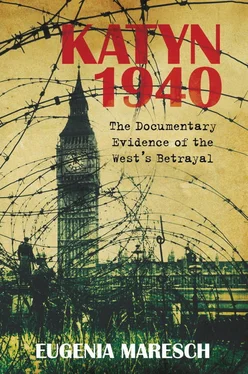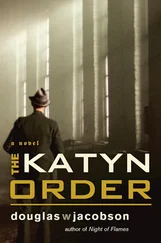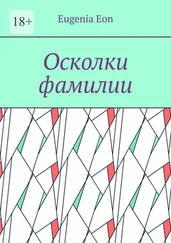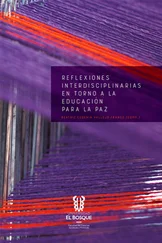The discovery of mass graves of Polish officers near Smolensk has caused an extraordinary sensation in world opinion and particularly in Polish émigré circles. Both the German Red Cross and the Polish émigré Government in London referred the matter to the International Red Cross and asked that a delegation should be sent to investigate; but the Soviet Government, whose relations with the Polish émigré Government had for some time been very strained, principally on account of the question of Poland’s eastern frontier, used the opportunity to make capital for their own view that Eastern Poland belong to the Soviet Union and also to disembarrass themselves of the uncomfortable Sikorski Government, they therefore broke off diplomatic relations with the Polish émigré Government on 25th April 1943.
Against this resounding success of German propaganda the Soviets had nothing to offer but fairy tales about ‘archaeological grave discoveries’ and the lie, which has been refuted by official documents, foreign journalists and neutral medico-legal authorities, that the Germans had murdered the Polish officers. The British and North American Governments recognised that the rupture of relations between the Soviet Union and the Polish émigré Government would have undesirable consequences, not only for Poland’s relationship to the Soviet Union, but also for their own, and further, that in view of the Atlantic Charter, the effect on the smaller States would not be favourable; they therefore set themselves to work at once and make vigorous efforts to put an end to the conflict. As a result the Polish émigré Government published a declaration, which was moderate in tone though its content was intransigent. It avoided the question of the International Red Cross being called on, but emphasised the integrity and unqualified sovereign rights of the Polish Republic and referred to the Polish-Soviet agreements of 30th July 1941 and 4th December 1941; it also repeated earlier demands that the Poles now in the Soviet Union should be released and that action to help them should be continued.
Further mediation was rendered difficult because in the first place it was impossible to accede to the Polish point of view on the real question at issue, namely the eastern frontier of Poland, without giving up one’s own, further, because the British Government had already admitted the Soviet ambitions on Eastern Poland and finally, because the Soviet Government saw no kind of ground for renouncing its claims. These efforts produced nothing but ambiguous observation by Stalin in a letter to The Times correspondent and Sikorski’s declaration on the subject and these made no change in the fundamental attitude of the two parties. Vyshinsky’s aggressive pronouncement to representatives of the British and North American Press, criticised the Polish Government for evacuating the Polish army from the Soviet Union, also on the ground of espionage by Polish officials, and also for approving the attempt of a group of Polish communists to organise a ‘Polish Division’ in the Soviet Union, but this rather complicated the position and provoked in England and North America a feeling of bitter disillusion. The Polish-Soviet conflict is a splendid example of the differences, which exist between the Allies. The behaviour of the Soviet Government proves that its object is the bolshevisation of Poland and indeed of Europe, and further that it is still pursuing its claim to the immediate hegemony of eastern and south-eastern Europe, and that when the Polish and other émigré` Governments in London entertain hopes of effective support from England and the United States, those hopes are a complete illusion.
Steengracht [Gustav Adolf von Moyland]
The Polish Section of SOE, ‘MP’ (the cryptic designation for clandestine operations organisation), unwittingly became involved in the Katyn affair towards the end of April, as the news of the unearthed mass graves filtered through by radio messages from Warsaw. A memorandum entitled ‘Katyn and After’ was compiled for the Foreign Office and PWE (Political Warfare Executive) desks and must have been read by the political department of SOE and approved by its head, Major General Colin McVean Gubbins. Curiously, there is no sign of the report being read or used for briefs by the EE&R Department (East European and Russian) of the FO. The report is long and covers political issues, such as: the significance of the massacre for Poland and the western democracies, what the object of the massacre was, why the Soviets broke relations with the Poles and how all this affects SOE. [25] TNA HS 4/137 ‘Katyn and After’, typescript carbon copy of a memorandum dated 21 April 1943, sent to L/S (Political Liaison Section, cryptic designation for GSOII) to Major T. G. Roche RA, Intelligence Division of SOE by ‘MPX’ (Major Richard Truszkowski 1897-1988), an SOE desk officer GSO II, who got to know the Russians during a previous posting to Russia. Truszkowski was born in the UK of Polish parents who were political exiles. Studied Chemistry, first in England then in Poland. During WW I served in France and then with the North Russia Expeditionary Force. At the outbreak of WW 2, joined the British Military Mission in Warsaw. Served again in Russia, France and Middle East. Awarded Krzyż Walecznych, the Polish Cross of Valour in 1943. The file also contains a comprehensive report entitled ‘German Propaganda’, edited by the Polish Ministry of Internal Affairs in London, which attracted more attention from the Secret Intelligence Service (SIS), than the memorandum.
The memorandum suggested that the news of finding the missing Polish officers did not surprise the London Poles – they almost expected it. What astonished them was that the dead bodies re-appeared so dramatically, and after being convinced of the truth of the German allegation, they were then compelled by the British to maintain silence about the massacre. It describes the Polish attitude towards the Western Allies as ‘almost childlike faith in the honesty of purpose’. The memo writer suggested that the Poles simply did not believe that Britain and the US would abandon them to the mercy of Russia. But the reason for the massacre had to be based on past and future Soviet ambitions. The Soviets hoped to dominate Eastern Europe, especially Poland, hence perhaps the social makeup of the Katyn victims – officials, military men, administrators, teachers, political leaders, doctors, lawyers, academics, writers and priests, who were an obstacle to their domination and had to be eliminated. This is however a simplistic view of Stalin’s motives to exterminate the elite of the Polish nation; the lack of documentation defying reasoning.
The main concern of SOE seems to be about those who were left behind in Poland, the AK (Armia Krajowa) Home Army, who were determined to survive by planning a general uprising, when the Western front was deemed close enough. The SOE document ‘Katyn and After’ refers to the possible clash in pointing out the Soviet anger at Sikorski bringing in the Red Cross.
The Soviet reaction to the announcement is not convincing. The suggestion first made was apparently that the Germans were trying to pretend that prehistoric remains known to be in this area were those of Polish officers. The second explanation was that Polish PoWs had been engaged on construction work in this area in 1941 when they were over-run by the Germans and massacred, and that the Germans were now accusing the Soviets of this crime. The third suggestion is that they were captured in 1941 and were only massacred recently, which would account for the good state of preservation of the bodies. General Sikorski’s action in asking for the Red Cross investigation has been violently condemned by the Soviets, which now suggest that General Sikorski and Hitler have concocted the whole matter as a frame-up. The balance of the evidence available appears to be that the German report is substantially correct.
Читать дальше












